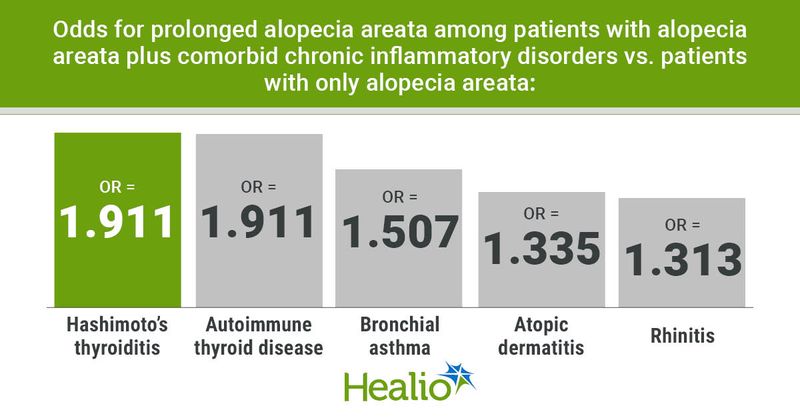Odds for poor alopecia areata outcomes high with comorbid asthma or atopic dermatitis
Key takeaways:
- Alopecia areata was classified as early-onset, severe or prolonged.
- Each additional atopic comorbidity raised the odds for each assessed alopecia areata classification.
Having asthma, Hashimoto’s thyroiditis or atopic dermatitis in addition to alopecia areata raised the odds for early-onset, severe and prolonged alopecia areata, according to a research letter published in Allergy.
“We found that comorbid bronchial asthma is a stronger risk factor for poor prognostic factors than comorbid atopic dermatitis or rhinitis,” Annika Friedrich, PhD student at the University of Bonn at University Hospital Bonn, said in a press release. “This is the first report of a significant association between comorbid asthma and the clinical features of [alopecia areata] in the literature.”

In this study, Friedrich and colleagues evaluated 2,657 patients with alopecia areata in Germany and Belgium to determine how various atopic and nonatopic chronic inflammatory disorders are linked to three different classifications of alopecia areata: early-onset (age 20 years or younger at disease onset), severe (“history of alopecia totalis, alopecia totalis/alopecia universalis or alopecia universalis during the most severe episode ever experienced”) and prolonged (at least one alopecia areata episode lasting longer than 2 years).
The presence of at least one comorbid chronic inflammatory disorder was reported by 53.7% of patients. Of those with an atopic disorder (44.5%), researchers found high proportions of patients with AD (26.7%) and rhinitis (26.7%), followed by bronchial asthma (13.4%).
Of those with a nonatopic disorder (17.4%), Hashimoto’s thyroiditis was reported by 6.1% of patients, with smaller proportions of patients reporting vitiligo (4.6%), psoriasis (2.7%) and rheumatoid arthritis (1.7%).
Results
Researchers observed significantly heightened odds for early-onset alopecia areata among patients with alopecia areata plus Hashimoto’s thyroiditis (OR = 1.502; 95% CI, 1.038-2.173), autoimmune thyroid disease (OR = 1.452; 95% CI, 1.022-2.062), bronchial asthma (OR = 1.446; 95% CI, 1.105-1.892), AD (OR = 1.27; 95% CI, 1.022-1.579) or rhinitis (OR = 1.238; 95% CI, 1.003-1.528) vs. patients with alopecia areata and no comorbid chronic inflammatory disorders.
Similarly, the odds for severe alopecia areata were significantly elevated in those with alopecia areata plus autoimmune thyroid disease (OR = 1.556; 95% CI, 1.131-2.141), Hashimoto’s thyroiditis (OR = 1.524; 95% CI, 1.088-2.135), bronchial asthma (OR = 1.47; 95% CI, 1.156-1.869) or AD (OR = 1.309; 95% CI, 1.083-1.582) vs. alopecia areata by itself, according to the study.
For prolonged alopecia areata, researchers found significantly higher odds for this outcome with comorbid Hashimoto’s thyroiditis (OR = 1.911; 95% CI, 1.328-2.748), autoimmune thyroid disease (OR = 1.911; 95% CI, 1.356-2.694), bronchial asthma (OR = 1.507; 95% CI, 1.16-1.957), AD (OR = 1.335; 95% CI, 1.086-1.643) or rhinitis (OR = 1.313; 95% CI, 1.073-1.606) vs. patients with alopecia areata without comorbid chronic inflammatory disorders.
In contrast to the findings for early-onset and severe alopecia areata, the study noted that the odds for prolonged alopecia areata significantly went up with comorbid vitiligo (OR = 1.578; 95% CI, 1.043-2.388).
Additional findings
Notably, each additional atopic comorbidity raised the odds for each assessed alopecia areata classification, with researchers reporting the greatest increase in the odds for prolonged alopecia areata (1.202), followed by early-onset (1.179) and severe (1.13) alopecia areata.
The mean age of alopecia areata onset among patients with alopecia areata and the three studied comorbid atopic disorders (AD, bronchial asthma and rhinitis) was 20.7 years, whereas the average age was 29.5 years among patients with only alopecia areata, according to the study.
The mean age of alopecia areata onset continued to be lower among those with a comorbid atopic disorder vs. only alopecia areata, as this age was 24.5 years in those with alopecia areata plus two atopic chronic inflammatory disorders and 25.3 years in those with alopecia areata plus one atopic chronic inflammatory disorder.
“Based on our results, we assume that [alopecia areata] patients with comorbid chronic inflammatory diseases, in particular atopic dermatitis, bronchial asthma or Hashimoto's thyroiditis, could benefit from more frequent clinical monitoring and earlier therapeutic intervention,” Regina C. Betz, MD, professor at the Institute of Human Genetics at the University Hospital Bonn, said in the release.
Reference:
- Inflammatory diseases influence the course of hair loss. https://www.uni-bonn.de/en/news/006-2025. Published Jan. 10, 2025. Accessed Jan. 10, 2025.

